A Symbol of Sacrifice
Mara H. Gottfried
Saint Paul Pioneer Press
May 14, 2008
St. Paul police had definite ideas about how a memorial bell to honor fallen officers should look and sound.
If two people could lift the bell, it was too small.
And, “we wanted a bell that wouldn’t ding; it needed to dong,” said officer Tim Bradley. “It resonates for 30 to 40 seconds. But more importantly, when this bell rings, we wanted it to tug on the very heartstrings of your soul.”
The St. Paul Police Memorial Bell will be rung publicly for the first time today at the annual ceremony to honor the 30 officers killed in the line of duty over the department’s 154 year history.
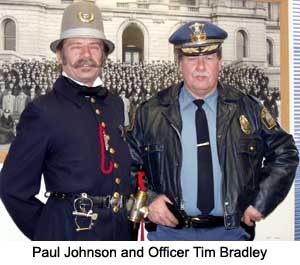 For Bradley and Paul Johnson, who was the St. Paul police forensic artist for about 20 years, the project has been a labor of love and elbow grease.
For Bradley and Paul Johnson, who was the St. Paul police forensic artist for about 20 years, the project has been a labor of love and elbow grease.
The men scoured the country for the perfect bell, designed a replica Civil War cannon carriage to carry it and had the oak-and-forged-steel carriage built.
Then, Bradley said, he and Johnson spent “an incredible amount of hours” sanding, staining and varnishing the carriage, pin-striping and painting the wheels, and adding details like a gold eagle on top of the bell and attaching replicas of the St. Paul police star badge from 1854, the year the department was founded, to the carriage.
The final result?
“It’s regal,” Johnson said.
The bell and cradle weigh 300 pounds, and the carriage about 800 pounds. It’s 8 feet 6 inches long, 5 feet 10 inches tall and 5 feet 1 inch wide. It will be transported on a trailer, but someday a horse might pull it.
Bradley, a St. Paul officer for 33 years, started thinking more about the department’s history and traditions after he recorded his memories for an oral history of the department by Kate Cavett, executive director of Hand in Hand Productions.
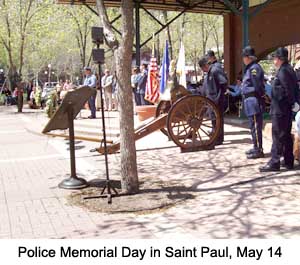 He became involved in the St. Paul Historical Society and last year started talking with Johnson, an active member of the group. Now retired, Johnson went on to become a forensic artist at the Minnesota Bureau of Criminal Apprehension after leaving the St. Paul Police Department.
He became involved in the St. Paul Historical Society and last year started talking with Johnson, an active member of the group. Now retired, Johnson went on to become a forensic artist at the Minnesota Bureau of Criminal Apprehension after leaving the St. Paul Police Department.
“We were talking about walking the walk and how it’s important to lead by example,” said Bradley, a Payne-Phalen beat officer. “We came up with this idea of the bell as a symbol of loss, courage and the ultimate sacrifice.”
The bell “couldn’t just be any bell,” he said. “The difference had to be in creativity and willingness to put elbow grease, blood, sweat and tears into it.”
They ordered a bronze bell from McShane Bell Foundry, in Glen Burnie, Md., which was founded in 1856. They had Hansen Wheel and Wagon Shop in Letcher, S.D., build 42-inch replica Prairie Howitzer cannon wheels.
Johnson, a Civil War enthusiast, showed Bradley a small replica of a cannon carriage. Bradley thought it was perfect to carry the bell, and Johnson came up with his own sketches.
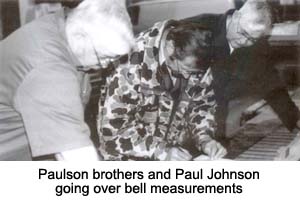 The men were thinking of building the carriage themselves until November, when Bradley was at police headquarters writing a police report and noticed a photo of an old cannon wheel in a copy of the Pioneer Press.
The men were thinking of building the carriage themselves until November, when Bradley was at police headquarters writing a police report and noticed a photo of an old cannon wheel in a copy of the Pioneer Press.
Bradley read the article, which was about twin brothers Bernie and Bruce Paulson, who run Paulson Bros. Ordnance Corp. in Clear Lake, Wis. He called Johnson immediately, and Johnson laughed—not only had he seen the article, he had the brothers’ number and was about to call them.
They met with the Paulson’s and brought along the wheels and Johnson’s sketches. The brothers built the carriage, and Bradley and Johnson picked it up in March.
“It was better than Christmas,” Bradley said of the day they picked it up. “We were squealing like two little kids.”
Since then, they’ve been working on the bell in a garage at the Eastern District office.
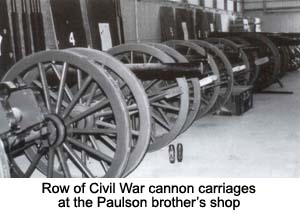 The St. Paul Police Federation is paying for the entire Memorial Bell Project and is raising money to offset the cost. While Bradley didn’t want to give the actual dollar amount, he said it is comparable to the price of a new Harley-Davidson motorcycle. The project was commissioned last year to coincide with the union’s 60th anniversary.
The St. Paul Police Federation is paying for the entire Memorial Bell Project and is raising money to offset the cost. While Bradley didn’t want to give the actual dollar amount, he said it is comparable to the price of a new Harley-Davidson motorcycle. The project was commissioned last year to coincide with the union’s 60th anniversary.
“We couldn’t think of a better way of honoring our officers who gave the ultimate sacrifice,” said Dave Titus, Federation president.
Each year, the bell will be rung at the department’s ceremony for fallen officers, and it can be brought to funerals for officers killed in the line of duty, Bradley said. Otherwise, Bradley and Johnson expect the bell to reside in the lobby of the Western District, which houses a police museum. As much as the bell is to honor fallen officers, it’s also for their families, Bradley said.
“It’s important to have something tangible,” he said. “The years are passing by, and time marches on, but we will not forget them. We will never forget.”
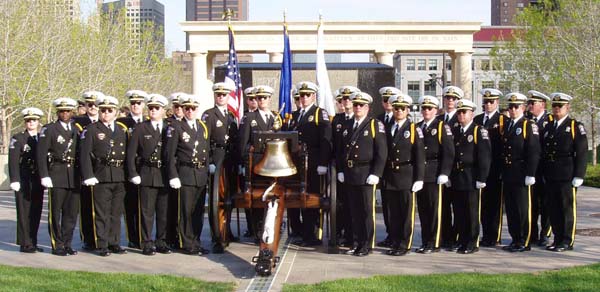
LEMA Honor Guard and the bell at Law Enforcement Memorial
at State Capitol grounds, May 15, 2008
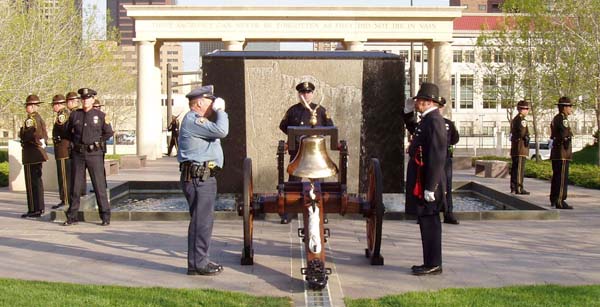
Officer Tim Bradley and Paul Johnson
at the State Law Enforcement Memorial, May 15, 2008
